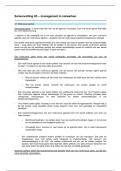Summary
Corporate Finance and Behaviour UU ECB2 - Summary of All Material
- Course
- Institution
- Book
Summary of all the material covered in the course ECB2FIN: Corporate Finance and Behaviour (year 2). This document includes a summary of the textbook (Brealey / Myers / Allen - Principles of Corporate Finance) and an explanation of the market efficiency theory and call / put options.
[Show more]













